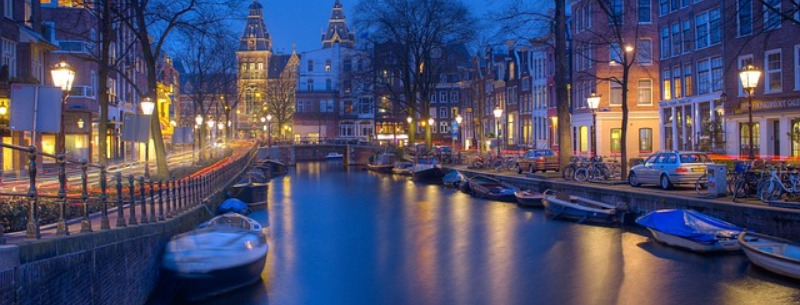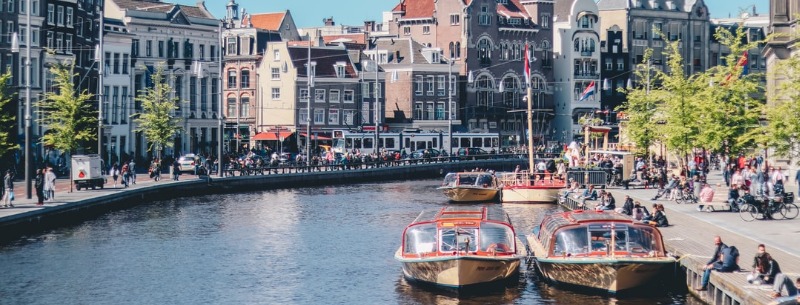2024 Netherlands Visitor Guide
The Netherlands is a country partly reclaimed from the waters of the North Sea, and around half of it lies at or below sea level. Land reclamation has been the dominant motif of its history, the result of a country of resonant and unique images – flat, fertile landscapes punctured by windmills and church spires; ornately gabled terraces flanking peaceful canals; and mile upon mile of grassy dunes, backing onto stretches of pristine sandy beach. A leading colonial power, its mercantile fleets once challenged the best in the world for supremacy, and the country enjoyed a so-called “Golden Age” of prosperity in the seventeenth century. These days, the Netherlands is one of the most developed countries in the world, with the highest population density in Europe, its sixteen million or so inhabitants (most of whom speak English) are concentrated in an area about the size of southern England.
Most people travel only to the uniquely atmospheric capital, Amsterdam: the rest of the country, despite its accessibility, is comparatively untouched by tourism. The west of the country is the most populated and most historically interesting region – unrelentingly flat territory, much of it reclaimed, that is home to a grouping of towns known collectively as the Randstad (literally “rim town”). It’s a good idea to forsake Amsterdam for a day or two and investigate places like Haarlem, Leiden, and Delft with their old canal-girded centers, the gritty port city of Rotterdam, or The Hague, the stately home of the government and the Dutch royals. Outside the Randstad, life moves more slowly. The province of Zeeland, in the southwest, is the country at its most remote, its inhabitants a sturdy, distant people, busy with farming and fishing and hardly connected to the mainland. In the north, Groningen is a busy cultural center, lent verve by its large resident student population. To the south, around the town of Arnhem, the landscape undulates into healthy moorland, best experienced in the Hoge Veluwe National Park. Further south still lies the compelling city of Maastricht, squeezed between the German and Belgian borders.
Though “Holland” is often used as a shorthand alternative name for the country, this is strictly speaking outdated; these days, although there are two Dutch provinces called North Holland and South Holland, they are separate entities. On the same note, it’s common to call Belgium and the Netherlands “the Low Countries”, and to use the abbreviation “Benelux” to refer to the neighboring trio of Belgium, the Netherlands, and Luxembourg
Top Attractions in the Netherlands
The Keukenhof Gardens
If you’re going to Holland to see the tulips, the Keukenhof Gardens in Lisse are the place to go – in spring, they are an unmissable riot of fragrance and color.
The North Sea Jazz Festival
Holland’s seat of government, The Hague, is admittedly neighboured by racier and more attractive metropolises, but once a year the city gets its own back. The North Sea Jazz Festival, held every July, attracts top-flight musicians and is well worth making a special effort to get to.
Hoge Veluwe National Park
If you crave a bit of peace and quiet after the bustle of Amsterdam, head for the densely wooded Hoge Veluwe National Park, just east of the city. It has the added attraction of the Kröller-Müller Museum in the heart of the park, home to the finest collection of Van Goghs in the world.
Amsterdam
Needless to say, Amsterdam in all its beauty, style, and energy is Holland’s number-one attraction and among the most magnetic and vibrant cities in the world.
Maastricht
The small town of Maastricht at the southern tip of the country has all the best elements of French, Belgian, German, and Dutch street culture – a combination of pavement cafés, top-quality beer and excellent cuisine with a handful of cannabis coffeeshops thrown in for good measure.
Delft’s Nieuwe Kerk
The view from the 100-meter tower of Delft’s Nieuwe Kerk takes in a quintessentially Dutch townscape of gabled red-roofed houses and tree-lined canals. Come out of season, though, to avoid the crowds that clog its narrow cobbled streets in summer.
Boymans-Van Beuningen Museum
Rebuilt after the blitz of 1940, the center of Rotterdam is a sterile and formless assembly of concrete and glass, but it boasts one of the country’s best – and most overlooked – museums, the Boymans-Van Beuningen, whose vast collection encompasses everything from Flemish masters to Pop Art.
The Nederlands Openluchtmuseum
The Nederlands Openluchtmuseum is a one-off architecture and crafts museum near Arnhem. With reconstructed buildings and costume collections culled from all over Holland, it charts the changes in rural life over the past two centuries – a good way to get behind the Dutch hats and clogs clichés.
Amsterdam
AMSTERDAM is a beguiling capital, a compact mix of the provincial and the cosmopolitan. It has a welcoming attitude towards visitors and a uniquely youthful orientation. For many, however, its world-class museums and galleries – notably the Rijksmuseum, with its collection of seventeenth-century Dutch paintings, and the Van Gogh Museum – are reason enough to visit. Amsterdam was founded on a dam on the river Amstel in the thirteenth century. During the Reformation it rose in stature, taking trade away from Antwerp and becoming a haven for its religious refugees. Having shaken off the yoke of the Spanish, the city went from strength to strength in the seventeenth century, becoming the center of a vast trading empire with colonies in Southeast Asia. Amsterdam accommodated its expansion with the cobweb of canals that gives the city its distinctive and elegant shape today. Come the eighteenth century, Amsterdam went into gentle decline, re-emerging as a fashionable focus for the alternative movements of the 1960s. Despite a backlash in the 1980s, the city still takes a uniquely progressive approach to social issues and culture, with a buzz of open-air summer events, intimate clubs and bars, and a relaxed attitude to soft drugs
Randstad towns
The string of towns known as the Randstad, or “rim town”, situated amid a typically Dutch landscape of flat fields cut by canals, form the country’s most populated region and recall the seventeenth-century heyday of the provinces of North and South Holland, of which they are now apart. Much of the area is easily visited by means of day trips from Amsterdam, but it’s more rewarding – and not difficult – to make a proper tour. Haarlem is definitely worth an overnight stop, while to the south, the university center of Leiden makes a pleasant detour before you reach the refined tranquillity of The Hague and the seedy lowlife of Rotterdam. Nearby Delft and Gouda repay visits too, the former with one of the best-preserved centers in the region.
Outside the Randstad towns, the Netherlands is a relatively unknown territory to visitors. In the north, the island of Texel has the country’s most complete beach experience, with plenty of birdlife and the world’s biggest catamaran races. In the northeast, the main draw is Groningen, a lively, cosmopolitan town with a buzzing streetlife – especially after dark – and a stunning museum and art gallery. To the south, the countryside grows steadily more rolling as you head towards Germany. The town of Arnhem is famous for its bridge, a key objective in the failed Allied attack of 1944; it also boasts one of the country’s best modern art museums and is a good base for the nearby Hoge Veluwe National Park. Further south, in the provinces of North Brabant and Limburg, the landscape slowly fills out, rolling into a rougher countryside of farmland and forests and eventually into the hills around Maastricht, a city whose vibrant, pan-European air, is a world away from the clogs and canals of the north. The southwest, near the Belgian border across from Bruges and Antwerp, is a land apart, with the Delta Expo near Middelburg dramatically highlighting the country’s long-standing tussle with the sea for supremacy.
Visit the Netherlands: Top Attractions
The Netherlands is a country in Europe, located near the North Sea, Belgium, and Germany. The name of this country literally means “low countries”, as about 20% of its area is below sea level. Famous for its capital city – Amsterdam – and its freedom-oriented lifestyle, the Netherlands is a beautiful country, worth exploring and discovering. Even though Amsterdam brought its fame, there are many lovely places to see in the rest of the country. Quaint towns with historic centers, windmills, flower gardens, sandy beaches… All can be found in the Netherlands!
Kinderdijk
As the Netherlands is known for its windmills, you’ll be pleased to find out that a large concentration of these staple objects of the country can be found near the village of Kinderdijk – 19 well-preserved old windmills, used for draining the excess water from polders situated below sea level! Today, Kinderdijk is one of the most loved tourist spots in this beautiful country.
Hoge – Veluwe National Park
It is one of the largest nature reserves in the Netherlands. Woodlands, heathlands, and sand dunes are all present on the grounds of the park. If you’re a fan of cycling, Hoge-Veluwe is a great place to visit, as it is inaccessible by car, and as bikes are offered for free to visitors. Also, in the midst of nature, you can find the Kröller-Müller Museum, where a large collection of Van Gogh’s paintings is displayed.
Keukenhof Gardens
The Netherlands is renowned for its flower industry, known also as the country of tulips. What better way to promote the Dutch flower industry than by opening the largest flower garden in the world? Yearly, around seven million flower bulbs are planted in the garden, with flowers ranging from the staple tulips to hyacinths, daffodils, and other spring flowers. The garden is open from late March to mid-May and is one of the most visited places in the country.
Getting to Holland
Trains
- Amsterdam to: Arnhem (every 30min; 1hr 10min); Delta Expo (via Middelburg; hourly; 2hr 30min); Groningen (every 30min; 2hr 20min); Haarlem (every 10min; 15min); The Hague (every 15min; 45min); Leiden (every 15min; 35min); Maastricht (hourly; 2hr 30min); Rotterdam (every 30min; 1hr 10min); Schiphol Airport (every 15min; 20min); Texel (via Den Helder; every 30min; 1hr 15min); Utrecht (every 30min; 30min).
- Arnhem to: Amsterdam (every 30min; 1hr 10min); Utrecht (every 10min; 35min).
- Groningen to: Amsterdam (every 30min; 2hr 20min).
- Delta Expo to: Amsterdam (hourly; 2hr 30min).
- The Hague to: Delft (every 15min; 15min); Gouda (every 20min; 20min); Rotterdam (every 15min; 25min); Utrecht (every 20min; 40min).
- Leiden to: Amsterdam (every 30min; 35min); The Hague (every 30min; 35min).
- Maastricht to: Amsterdam (hourly; 2hr 30min).
- Rotterdam to: Gouda (every 20min; 20min); Utrecht (every 20min; 45min).
- Utrecht to: Arnhem (every 15min; 30min).



